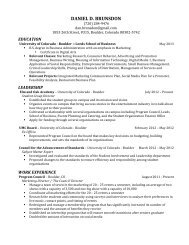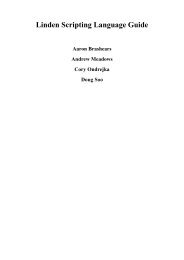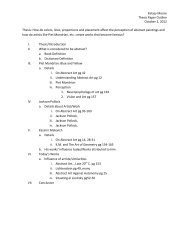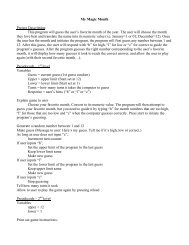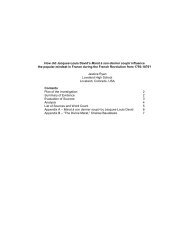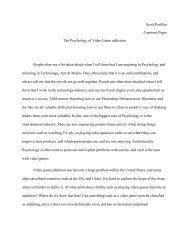Savant Syndrome: A Duality of Genius and Handicap - Engineering ...
Savant Syndrome: A Duality of Genius and Handicap - Engineering ...
Savant Syndrome: A Duality of Genius and Handicap - Engineering ...
You also want an ePaper? Increase the reach of your titles
YUMPU automatically turns print PDFs into web optimized ePapers that Google loves.
<strong>Savant</strong> <strong>Syndrome</strong>:<br />
A <strong>Duality</strong> <strong>of</strong> <strong>Genius</strong> <strong>and</strong> H<strong>and</strong>icap<br />
Bradley Henke<br />
Honors Socratic Seminar<br />
Mrs. Richards<br />
March 11, 2008
Henke, 2<br />
<strong>Savant</strong> <strong>Syndrome</strong> ranks among <strong>of</strong> the world‟s most mysterious <strong>and</strong> inexplicable<br />
phenomenons. It is a condition in which an individual, despite severe intellectual impairment,<br />
possess extraordinary abilities (Treffert xxv). Mental disability may render George <strong>and</strong> his<br />
identical twin Charles incapable <strong>of</strong> counting to thirty, but if they are given a date within 40,000<br />
years <strong>of</strong> the past or future the twins can name the day <strong>of</strong> the week that the date fell or will fall on<br />
(Treffert 36). Thomas Fuller was an African slave during 1788 (Treffert 55). He was described<br />
as severely mentally h<strong>and</strong>icapped. Yet, Fuller was able to correctly calculate nine digit by nine<br />
digit multiplication in his head, <strong>and</strong> in a matter <strong>of</strong> seconds (Treffert 55). As an autistic savant<br />
himself, Daniel Tammet describes the “line between pr<strong>of</strong>ound talent <strong>and</strong> pr<strong>of</strong>ound disability [as]<br />
a really surprisingly thin one” (Brainman). <strong>Savant</strong> <strong>Syndrome</strong> is an enigma <strong>of</strong> the brain which<br />
challenges scientists to reevaluate the concept <strong>of</strong> genius. Each savant has a unique story which<br />
sheds light on the mysterious power <strong>of</strong> the brain. Naturally, this wonderfully mysterious<br />
phenomenon also begs the questions, “What gives a savant his or her incredible ability? Is the<br />
capacity for truly amazing talents simply locked away somewhere in every man‟s head? If so,<br />
could it be accessed or even completely unlocked?”<br />
<strong>Savant</strong> <strong>Syndrome</strong> is a relatively new branch <strong>of</strong> psychology. The phenomenon was first<br />
properly recognized by Dr. J. Langdon Down (the prominent London doctor is also known for<br />
originating the term “Down‟s <strong>Syndrome</strong>”) (Hiles). In 1887, Dr. Down described a person with<br />
incredible ability but serious mental h<strong>and</strong>icap as an “idiot savant” (Treffert xii). When the term<br />
“idiot savant” was first coined, “idiot” was an accepted medical terminology that referred to an<br />
individual with an I.Q. <strong>of</strong> less than 25 (Treffert xii). “<strong>Savant</strong>” is a word derived from the French<br />
language literally meaning “to know” or “man <strong>of</strong> learning” (Treffert xii). “Autistic savant” is<br />
<strong>of</strong>ten used interchangeably with “idiot savant” (Hiles). However, the terminology now accepted
Henke, 3<br />
to describe this phenomenon is “savant syndrome” (Treffert). Correct terminology is important<br />
in recognizing the syndrome because very few savants can accurately be described as “idiot” or<br />
“autistic”. Most savants have an I.Q. that far exceeds 25; along with the inaccuracy <strong>of</strong> the term,<br />
“idiot” has a strong negative connotation in present society which is unfairly attributed to<br />
amazingly gifted individuals (Treffert xii). The term “autistic savant” can be misleading because<br />
only half <strong>of</strong> savants are autistic; the other half <strong>of</strong> savant cases come from various developmental<br />
disorders <strong>and</strong> brain injuries (Hiles). From the two pools <strong>of</strong> people, savant qualities appear in<br />
roughly 10% <strong>of</strong> the autistic population <strong>and</strong> in less than 1% <strong>of</strong> injury <strong>and</strong> developmental disorder<br />
populations (Hiles). Therefore, there is a higher incident rate <strong>of</strong> savants in the autistic population<br />
which may have led to the development <strong>of</strong> the term.<br />
<strong>Savant</strong>s are best described by two categories <strong>of</strong> people. “Talented savants” possess<br />
abilities that seem remarkable in comparison with their h<strong>and</strong>icap (Treffert xii). “Prodigious<br />
savants” maintain abilities that seem remarkable even for a normal person (Treffert xii).<br />
Prodigious savants are few <strong>and</strong> far between; it is estimated that fewer than 100 prodigious<br />
savants have lived worldwide in the last 100 years (Hiles).<br />
Although not all cases <strong>of</strong> savant syndrome coincide with autism, the greater tendency <strong>of</strong><br />
having savant-like qualities while being part <strong>of</strong> the autistic spectrum clearly demonstrates a link<br />
between the two disorders. Autism afflicts one child out <strong>of</strong> every 500 children born (Edwards 9).<br />
The condition is four times more likely to affect boys than girls; however, it is noted that girls<br />
with autism tend to have more severe symptoms <strong>and</strong> lower intelligence than most autistic boys<br />
(Edwards 9). The probability <strong>of</strong> being autistic is not affected by demographic features like social<br />
class, race, ethnicity, lifestyle, or educational background (Edwards 9). Also, to clarify, autism is<br />
a disorder not a disease (Edwards 12). Unlike diseases, there are not symptoms <strong>of</strong> autism
Henke, 4<br />
(Edwards 12). Doing a “blood test will not indicate the presence <strong>of</strong> autism, nor will an X ray, a<br />
urinalysis, or a biopsy. So doctors rely exclusively on behavior to determine whether or not a<br />
child is autistic” (Edwards 12). The National Institute <strong>of</strong> Mental Health classifies autism as a<br />
brain disorder which affects a person‟s ability to communicate, form relationships with others,<br />
<strong>and</strong> act appropriately in an environment (Edwards 12). Furthermore, they may be high<br />
functioning, retarded, or mute, <strong>and</strong> they <strong>of</strong>ten seem closed <strong>of</strong>f indulging in repetitive behaviors<br />
<strong>and</strong> “rigid patterns <strong>of</strong> thinking” (Edwards 13). Because <strong>of</strong> the wide variety <strong>of</strong> autistic behaviors it<br />
is best to think <strong>of</strong> autism as a spectrum disorder <strong>of</strong> high-functioning to low-functioning<br />
characteristics (Hiles). A specific higher-functioning form <strong>of</strong> Autism is called Asperger‟s<br />
syndrome (Edwards 74). It is characterized by normal intelligence <strong>and</strong> language development,<br />
but accompanied by “marked deficiencies in social <strong>and</strong> communication skills” (Edwards 74).<br />
Individuals with Asperger‟s syndrome are <strong>of</strong>ten single-minded <strong>and</strong> compelled to analyze details<br />
<strong>and</strong> systems (Tammet 7). The disorder is comprised <strong>of</strong> 90% males. The disorder is not something<br />
that develops over time; it is something a man is born with (Tammet 7).<br />
Strangely enough, savant talents usually fall into a narrow list <strong>of</strong> abilities; however, many<br />
times savants possess more than one talent (Hiles). The skills <strong>of</strong>ten have very little in common,<br />
except for one defining trait – all savants have an unusually large capacity for storing <strong>and</strong><br />
recalling memory (Treffert xiii). Also, in most cases, the talents that savants develop are<br />
controlled by the brain‟s right hemisphere which is responsible for “non-symbolic, artistic,<br />
concrete, <strong>and</strong> directly perceived” actions <strong>and</strong> ideas (Hiles). Most savants‟ talents fall into the<br />
categories <strong>of</strong> memorization, lighting calculation, calendar calculation, musical ability, artistic<br />
ability, <strong>and</strong> language ability (Hiles). Surprisingly, very few other abilities are attributed to<br />
savants (Treffert 92). Some <strong>of</strong> the less common skills include mechanically ability, unusual
Henke, 5<br />
sensory discrimination, extrasensory perception, precise sense <strong>of</strong> time, <strong>and</strong> sense <strong>of</strong> direction<br />
(Treffert 92-98). Mechanical savants have an unusual ability to draw out blueprints <strong>and</strong> assemble<br />
parts <strong>of</strong> everyday objects to make simple machines; in one case a child took apart a clock <strong>and</strong><br />
rigged it up as an affective windmill (Treffert 92). One child with unusual sensory discrimination<br />
for touch was able to peel apart a page <strong>of</strong> magazine into two perfect <strong>and</strong> separate sheets <strong>of</strong> paper<br />
as one would do with a stamp envelope (Treffert 96). <strong>Savant</strong>s with extrasensory perception<br />
abilities are unexplainable <strong>and</strong> <strong>of</strong>ten viewed as near psychic (Treffert 96). <strong>Savant</strong>s are sometimes<br />
documented to have an ESP like ability to predict r<strong>and</strong>om events before they occur (Treffert 96).<br />
Statistically speaking, from the repeated instances <strong>of</strong> the predictions becoming true, the<br />
“probability for coincidental knowledge [is] nil” (Treffert 97).There are a few documented cases<br />
<strong>of</strong> savants with a precise sense <strong>of</strong> time who are able to predict the current time, to the minute,<br />
without looking at a clock (Treffert 98). <strong>Savant</strong>s with a keen sense <strong>of</strong> direction can give detailed<br />
directions to any destination they have traveled to – on a street by street, block by block<br />
breakdown (Treffert 99). Yet, most skills fall into the other categories.<br />
An expansive memory is characteristic <strong>of</strong> all savants, but for some memorization alone is<br />
a fantastic ability. There are several cases <strong>of</strong> <strong>Savant</strong>s who are able to memorize vast sums <strong>of</strong><br />
knowledge (Treffert 68). One young man named Gordon could repeat “verbatim a story <strong>of</strong> 1,500<br />
words after six or seven readings” (Treffert 69). Gordon was unable to dress himself (Treffert<br />
70). He had an amazing ability to retain language, but like many other skilled memorizers, he<br />
was unable to comprehend what he read (Treffert 70). For most savants, “extraordinary memory<br />
was associated with very great defect <strong>of</strong> reasoning power” (Treffert 71). Memorization is a broad<br />
category. <strong>Savant</strong>s have been documented to memorize:
Henke, 6<br />
… names <strong>and</strong> dates <strong>of</strong> many kinds, addresses, zip codes, area codes <strong>and</strong> telephone<br />
numbers, many types <strong>of</strong> population statistics, geographical information,<br />
timetables, poetry, stories (recalled word for word), license plate numbers, menus,<br />
road maps, date-based information about family events, weather reports, news<br />
items, locomotive engine numbers <strong>and</strong> freight train car numbers, stations on<br />
railway routes, songs, word spellings (backwards as well as forwards), birthdays,<br />
street sequences, word-by-word records <strong>of</strong> conversations, television <strong>and</strong> film<br />
scripts, sporting events <strong>and</strong> statistics, <strong>and</strong> astronomical information. (Howe 41)<br />
The list is endless. <strong>Savant</strong>s feel compelled to memorize such figures. Often times, however, it is<br />
startling to learn that the savants have little or no interest in the things that they memorize (Howe<br />
41). For example, one seven year old child learned both the English <strong>and</strong> Latin names <strong>of</strong> 18<br />
varieties <strong>of</strong> deer (Howe 41). He accomplished this feat in spite <strong>of</strong> the fact that he had no apparent<br />
interest in the deer themselves; he would be completely unable to recognize any such breed <strong>of</strong><br />
deer if it had stumbled upon his path (Howe 41). Exceptional memory is one <strong>of</strong> the only real<br />
links between all savant abilities; which, if explained, may be the key to underst<strong>and</strong>ing savant<br />
syndrome (Treffert xii).<br />
Very little is known about lightning calculation. It is a skill found on both ends <strong>of</strong> the<br />
intelligence spectrum (meaning both the mentally challenged <strong>and</strong> true geniuses without<br />
disability) (Treffert 55). There are very few average people that possess this ability (Treffert 55).<br />
Steven B. Smith, author <strong>of</strong> The Great Mental Calculators, explains this gap <strong>of</strong> intelligence as a<br />
lack <strong>of</strong> interest in math for the average man (Treffert 55). Those who can do lightning<br />
calculation, overwhelmingly, describe numbers as their “friends” (Treffert 55). Thomas Fuller<br />
was an African slave in Virginia during the late 1700s (Treffert 56). All information available
Henke, 7<br />
describes Fuller as seriously mentally h<strong>and</strong>icapped (Treffert 56). While doing his jobs as a slave,<br />
Fuller became preoccupied with counting (Treffert 56). He started by counting bushels <strong>of</strong> wheat<br />
<strong>and</strong> then one day became so obsessive that he counted every hair on one <strong>of</strong> his cow‟s tail<br />
(Treffert 56). Because <strong>of</strong> his slave status, Fuller never had a math class or any type education<br />
(truthfully he probably would not have been able to comprehend them if he did) (Treffert 56).<br />
Yet despite his severe mental h<strong>and</strong>icaps, he could easily multiply nine digit numbers by nine<br />
digit numbers. In 1788 Fuller was tested with three questions to detect his math abilities (Treffert<br />
56). The first question “how many seconds are in one <strong>and</strong> one half years” was answered<br />
correctly (47,304,000) in less than two minutes (Treffert 56). The second question “how many<br />
seconds has a man been living if he is 70 years 17 days <strong>and</strong> 12 hours old” was answered in 90<br />
seconds as 2,210,500,800 (Treffert 56). Upon hearing this answer two <strong>of</strong> the three judges<br />
immediately told Fuller that he had given an incorrect answer; after reciting what the correct<br />
answer should be Fuller immediately replied “Masa, you forgot d‟leap year” (Treffert 56). Upon<br />
reexamination the judges agreed that Fuller had indeed given the correct answer <strong>and</strong> so<br />
continued to the third question, “Suppose a farmer has six sows <strong>and</strong> each sow has six female pigs<br />
the first year, <strong>and</strong> they all increase in the same proportion to the end <strong>of</strong> eight years. How many<br />
sows would the farmer then have” (Treffert 56). After ten minutes <strong>of</strong> contemplating, Fuller gave<br />
the correct answer 34,588,806 (Treffert 56). A second prodigious case <strong>of</strong> lightning calculation<br />
occurred in the 1700s as well (Treffert 57). Jedediah Buxton “like Fuller was very limited<br />
intellectually” (Treffert 57). Buxton was once asked to calculated the cost <strong>of</strong> shoeing a horse<br />
“with 140 nails if the price was one farthing for the first nail <strong>and</strong> the price was doubled for each<br />
<strong>of</strong> the remaining 139 nails (2 to the power <strong>of</strong> 139); Buxton‟s answer was<br />
725,958,238,096,074,907,868,531,656,993,638,851 pounds, 2 shillings <strong>and</strong> 8 pence (Treffert
Henke, 8<br />
57). This problem was extremely complicated because it involved converting money as well as<br />
calculating huge numbers; a modern computer determined his number to be incorrect (Treffert<br />
57). However, the first four digits <strong>and</strong> the last eight digits were correct as well as the spare<br />
change (Treffert 57). Buxton then spent the next two <strong>and</strong> a half months squaring this 28 digit<br />
number in his head <strong>and</strong> a modern computer has verified that he correctly calculated the 78 digit<br />
number in all but one digit (Treffert 57). This type <strong>of</strong> mental capacity is truly extraordinary.<br />
Buxton‟s example demonstrates that the power <strong>of</strong> the brain in almost limitless in its ability. Two<br />
identical twin savants, George <strong>and</strong> Charles, demonstrated a unique type <strong>of</strong> lightning fast<br />
calculation. Both twins were able to count 111 matches, after they were spilled out <strong>of</strong> a<br />
matchbox, <strong>and</strong> before they hit the ground; upon retrieving the matches from the floor it was<br />
verified that exactly 111 matches had been spilt (Treffert 67). The means by which these feats<br />
are done is unexplainable. The best answer that scientists have is that perhaps savants are<br />
“capable <strong>of</strong> foreseeing the solution to a problem or long arithmetic operation without carrying<br />
out the details <strong>of</strong> the calculations” (Treffert 67).<br />
On the same lines as Lightning Calculation is Calendar Calculation. It is “the ability to<br />
identify the day <strong>of</strong> the week upon which a particular date falls” (Hiles). The odd thing about<br />
calendar calculation is that it appears uncommonly <strong>of</strong>ten in savants (Treffer xiii). David Tammet,<br />
a prodigious savant <strong>and</strong> calendar calculator himself, believes that the ability to calendar calculate<br />
stems from the fascination, especially demonstrated in autistic individuals, savants have with<br />
pattern, order, <strong>and</strong> systems which are all vital parts to calendar calculation (Tammet 8). When<br />
discussing calendar calculators, no one represents the category better than George <strong>and</strong> his<br />
identical twin brother Charles (Treffert 36). Both brothers are prodigious savants that can name<br />
the day <strong>of</strong> the week that any date has fallen or will fall on (Treffert 36). They have been tested to
Henke, 9<br />
accurately name dates both 40,000 years in the future <strong>and</strong> past; a span <strong>of</strong> over 80,000 dates<br />
(Treffert 36). “Ask them to name in which years, in the next or any 200, Easter will fall on<br />
March 23 <strong>and</strong> they will name those years with lightning rapidity, faster than a computer”<br />
(Treffert 36). The brothers can also recount weather with surprising detail, such as the time the<br />
sun rose <strong>and</strong> the hour it began raining, for any day in their adult lives, yet after asking them a few<br />
simple questions they will have had sufficient time to forget the questioner‟s name (Treffert 39).<br />
The brothers are severely mentally challenged <strong>and</strong> unable to count to 30, but in their spare time<br />
“the brothers swap 20 digit prime numbers for amusement” (Treffert 39). The twin are unable to<br />
add or subtract single digit numbers, however, if asked to tell you how many weeks it has been<br />
since your last birthday, George will tell you that it has been 30 weeks since your last birthday<br />
<strong>and</strong> 13 weeks till your next one (Treffert 36, 38). Without underst<strong>and</strong>ing the rules <strong>of</strong><br />
mathematics the twins are able to unconsciously factor numbers, commit to memory 3 digit, 30<br />
digit, or 300 digit numbers with equal ease (Treffert 40). When asked how they were able to do<br />
such amazing things the answer George replied with is “It‟s in my head <strong>and</strong> I do it” (Treffert 39).<br />
This is a typical response <strong>of</strong> savants; they are unable to explain how they consciously do their<br />
magic, which may suggest that everything truly is done subconsciously. Hermelin <strong>and</strong> O‟Conner<br />
<strong>of</strong> the Institute <strong>of</strong> Education in London are top researchers <strong>of</strong> Calendar Calculating (Treffert 50).<br />
They wanted to know whether or not the ability was based on math or memory (Treffert 50).<br />
They “concluded that memory alone could not explain the skill. They postulated that, in addition<br />
to using some arithmetic calculating skill, the savants also used the rules that govern the<br />
Gregorian Calendar” (Treffert 51). Dr. Treffert, currently the world‟s authority on savant<br />
syndrome, used Hermelin‟s <strong>and</strong> O‟Conner‟s results to theorize that “the underlying method for<br />
most savant calendar calculators is the ability <strong>of</strong> the human brain to form unconscious algorithms
Henke, 10<br />
on the basis <strong>of</strong> examples” (Treffert 54). This is the only way to explain the twins calculating<br />
ability because they could not consciously add or subtract anything (Treffert 54). At first the idea<br />
seems extremely irrational <strong>and</strong> improbable, but “analogous to this would be the fact that many<br />
persons use language without being able to verbalize rules <strong>of</strong> grammar <strong>and</strong> sentence<br />
construction. They may not know how they use language, but they can use it nonetheless”<br />
(Treffert 54). I find this explanation extremely satisfying. I practice the use <strong>of</strong> language every<br />
single day just as the twins were compelled to do calculations every single day. For a very long<br />
time I was unaware <strong>of</strong> grammar rules. Even today I still find that some words just sound “right”<br />
in certain instances <strong>of</strong> grammar, despite the rules. For them to become prodigious at<br />
subconscious calculation, which is something they are predisposed to succeed in due to savant<br />
syndrome, is not a very large leap <strong>of</strong> faith for me.<br />
The twins were institutionalized when they were nine years old (Treffert 37). After years<br />
<strong>of</strong> being together, it was decided that they should be separated “for their own good <strong>and</strong> to<br />
prevent unhealthy communication together” (Treffert 41). They were separated to be able to<br />
“come out <strong>and</strong> face the world in an appropriate, socially acceptable way” (Treffert 41). Both<br />
were moved to half-way houses to do menial jobs for pocket money (Treffert 41). It is true that<br />
they were able to partially adapt to their new worlds becoming “quasi-independent <strong>and</strong> socially<br />
acceptable,” but in the process, both twins seemed to “have lost their strange numerical power,<br />
<strong>and</strong> with this the chief joy <strong>of</strong> their lives” (Treffert 41). The treatment <strong>of</strong> individuals with savant<br />
syndrome is a reoccurring dilemma. Should they be encouraged to conform, if possible, to<br />
society, or instead live <strong>and</strong> alternative lifestyle while being supremely content <strong>and</strong> happy with<br />
their own worlds? To me, risking a prodigious skill for a “normal live” seems like a waste <strong>of</strong> true
Henke, 11<br />
talent. It would seem ridiculous to tell Stephan Hawkins to stop studying space, even if he were<br />
eccentric; why should it be any different with savants?<br />
Musical savants display some <strong>of</strong> the most amazing characteristics <strong>of</strong> savant syndrome.<br />
Prodigious musical savants are exceptionally rare; among the developmentally disabled they<br />
appear in 0.06% <strong>of</strong> the population (Miller 10). According to Miller, “most musical savants are<br />
male, visually impaired, <strong>and</strong> have a history <strong>of</strong> language disorder,” but he also recognizes that<br />
musical savants are not formula made (Miller 190). It is interesting to note that there is a<br />
“frequently occurring triad <strong>of</strong> blindness, mental defect <strong>and</strong> musical genius,” <strong>and</strong> although not<br />
every musical savant is blind, the three attributes occur with “startling regularity” (Treffert 19).<br />
Musical savants have absolute pitch (Miller 45). Each musical note is a sound wave vibrating at<br />
certain frequency; the wavelength determines the note being played. The frequency <strong>of</strong> the<br />
wavelength can be increased to create separate harmonics. For savants, having absolute pitch is<br />
similar to having vision (Miller 45). The human eye picks up changes in the wavelengths <strong>of</strong> light<br />
waves, which is perceive as color (Miller 45). The frequency <strong>of</strong> the light waves may determine<br />
the brightness <strong>of</strong> a color (Miller 45). <strong>Savant</strong>s with absolute pitch not only have a similar response<br />
to sound as most people do to color, but they can differentiate between frequencies <strong>of</strong> sound<br />
waves which separate them from people who have learned to recognize different pitches (Miller<br />
45). Leslie Lemke was born mentally h<strong>and</strong>icapped <strong>and</strong> suffered from cerebral palsy (Wisconsin).<br />
His eyes were surgically removed due to disease (Wisconsin). His mother put him up for<br />
adoption when he was born, <strong>and</strong> he was taken in by a foster mother named May Lemke<br />
(Wisconsin). Doctors told May that Leslie should be institutionalized because his condition<br />
would never improve, <strong>and</strong> he would probably die in infancy (Wisconsin). They refused to follow<br />
that advice, <strong>and</strong> after several years <strong>of</strong> work, May was able to teach Leslie how to walk <strong>and</strong> eat
Henke, 12<br />
(Wisconsin). Leslie could not talk, but he mimicked conversation obsessively (Wisconsin). At<br />
age eight his mother gave him a piano, <strong>and</strong> many years later he learned how to play it<br />
(Wisconsin). Then one evening while May <strong>and</strong> her husb<strong>and</strong> were getting ready for bed they<br />
heard a noise that they thought was the TV (Wisconsin). They went downstairs to Leslie‟s room<br />
to discover him playing Tchaikovsky‟s Piano Concerto #1 which had been the theme song on a<br />
show that evening; Leslie Lemke was playing it flawlessly (Wisconsin). Lemke has a low IQ <strong>of</strong><br />
40 but his ability to reproduce music after one recital is phenomenal; he is able to perfectly play<br />
back any song played to him, regardless <strong>of</strong> complexity or length, after only one hearing<br />
(Wisconsin). He then retains the song forever (Wisconsin). He also developed a skill for<br />
imitating other musical styles <strong>and</strong> could play a song as other composers would have played it<br />
(Wisconsin). Lemke illustrates the power <strong>of</strong> memory in a savant‟s brain. Every detail seemed to<br />
be recorded, unfiltered, for every song he has ever heard. Today, two other musical savants<br />
posses the very same talents as Lemke.<br />
The last major category <strong>of</strong> savant syndrome deals with exceptional art skill. Researchers<br />
currently believe that artistic talent resides in an individual without regard to IQ (Treffert 88).<br />
People with amazing artistic talents are said to have an “art lexicon” which is an ability to store,<br />
access, <strong>and</strong> make use <strong>of</strong> information <strong>and</strong> relationships that affect the way in which art is created<br />
<strong>and</strong> perceived (Treffert 88). The story <strong>of</strong> Alonzo, which is still being written, illustrates the<br />
amazing abilities <strong>and</strong> successes that savants with artistic talents possess, despite serious mental<br />
h<strong>and</strong>icap. Alonzo Clemens is a sculptor with savant syndrome (Treffert 124). He was born in<br />
1956 in Boulder, Colorado with no complication <strong>and</strong> no disability (Treffert 124). At a very early<br />
age his mother describes him as having a precocious ability for sculpting, Play Doh being his<br />
medium <strong>of</strong> choice (Treffert 124). However, when Alonzo was three years old he had a bad fall
Henke, 13<br />
which caused brain damage; Alonzo‟s development slowed down dramatically (Treffert 124).<br />
Alonzo has an IQ <strong>of</strong> 40, but despite his low level <strong>of</strong> intelligence (he found it very difficult to<br />
count to ten), Alonzo was able to feed himself, care for himself, <strong>and</strong> transport himself by bus to a<br />
near by ranch where he worked as a extra h<strong>and</strong> (Treffert 124). Alonzo was not completely<br />
independent; he lived in a group home for people with developmental disabilities, but all<br />
considered, he cared for himself extremely well (Treffert 124). For Alonzo, sculpting has always<br />
been an obsession (Treffert 124). It is such a strong force in his life that once, while he was<br />
young, a school teacher decided to take away his clay in hopes that he would become more<br />
responsive to his education (Treffert 124). She was planning to use the clay as a reward for good<br />
progress, but the drive for Alonzo to sculpt was so strong that he resorted to sculpting figures out<br />
<strong>of</strong> tar that he picked from the pavement on the school grounds (Treffert 124). A short while later,<br />
the teachers discovered a small “menagerie” <strong>of</strong> miniature black sculptures under Alonzo‟s bed<br />
<strong>and</strong> grudgingly gave up on their reward system tactic <strong>of</strong> teaching (Treffert 124). Alonzo‟s<br />
favorite animal is the horse (Treffert 124). He can sculpt a perfect horse, or any animal for that<br />
matter, in less than an hour with perfect attention to detail (Treffert 124). Alonzo‟s skills are<br />
considered prodigious <strong>and</strong> his sculptures sell anywhere from $3000 to $45,000 per piece<br />
(Treffert 124). He has been recognized worldwide for his art <strong>and</strong> clients are <strong>of</strong>ten surprised to<br />
find out that the sculptures were created by a mentally h<strong>and</strong>icapped man (Treffert 124). Alonzo<br />
is able to sculpt any animal from a mere glance at a two dimensional picture; his mind is able to<br />
transfer the information into three dimensions which he then precedes to sculpt with<br />
unbelievable accuracy <strong>and</strong> precision (Treffert 124). This ability is another scientific mystery<br />
(Treffert 124). Alonzo claims that the answer is very simple stating, “God gives talent” (Treffert<br />
124). Alonzo has not had a single formal art class, yet his sculptors have improved drastically
Henke, 14<br />
over the years (Treffert 125). Alonzo‟s sculptures have always been extremely detailed, but now<br />
he has added vitality into his art work which is a sign <strong>of</strong> major improvement (Treffert 125).<br />
Today, Alonzo still lives in Boulder, Colorado; he owns his own studio <strong>and</strong> is saving money so<br />
that one day he will be able to buy his own horse to ride <strong>and</strong> enjoy.<br />
<strong>Savant</strong> <strong>Syndrome</strong> has been an especially difficult phenomenon to study because savants<br />
are few <strong>and</strong> far between, but also because technology has been changing drastically for many<br />
years. Today scientists are able to study the brain with much greater precision than before. The<br />
stories <strong>of</strong> Daniel Tammet <strong>and</strong> Kim Peeks may be crucial steps towards underst<strong>and</strong>ing savant<br />
syndrome because they are two <strong>of</strong> the world‟s greatest savants, <strong>and</strong> they also live in an age <strong>of</strong><br />
technology that can better document what is abnormal in their brains compared with the brain <strong>of</strong><br />
a typical human being.<br />
Daniel Tammet was born on July 31, 1979, which according to Tammet, was a “blue<br />
day” (Tammet 1). He was born with an extremely unique brain. Tammet has synesthesia which<br />
is a “rare mixing <strong>of</strong> the senses” (Tammet 2). People with synesthesia typically see alphabetical<br />
letters <strong>and</strong> numbers in color (in their mind‟s eye) (Tammet 2). Tammet has an extremely<br />
developed form <strong>of</strong> synesthesia which lets him associate not only colors with letters <strong>and</strong> numbers,<br />
but also shapes, textures, <strong>and</strong> motion (Tammet 2). Numbers are very important to Tammet<br />
because each is unique <strong>and</strong> each has its own personality <strong>and</strong> shape (Tammet 1). Daniel Tammet<br />
has also been diagnosed with Asperger‟s syndrome which presents itself in the form <strong>of</strong> an<br />
obsessive need for order <strong>and</strong> routine that affects every aspect <strong>of</strong> his life (for example, he always<br />
counts up the number <strong>of</strong> clothing articles he is wearing before leaving his house) (Tammet 1,6).<br />
Tammet is an extremely prodigious savant demonstrating amazing abilities in calendar<br />
calculation, lightning calculation, memorization, <strong>and</strong> language acquisition (Tammet 8, 11 <strong>and</strong>
Henke, 15<br />
Brainman). But what really sets him apart from other savants is his ability to describe what is<br />
happening in his brain (Brainman). Daniel Tammet demonstrates amazing abilities, but the<br />
effects <strong>of</strong> Asperger‟s syndrome make it extremely difficult for him to adapt <strong>and</strong> fit into society.<br />
One <strong>of</strong> the hardest things for Tammet to underst<strong>and</strong> is emotion (Tammet 7). Surprisingly, he<br />
associates certain numbers with certain feelings; the number six represents a void or emptiness<br />
for Tammet (Tammet 7). When he hears a friend say that “they feel sad or depressed, [he]<br />
pictures [himself] sitting in the dark hollowness <strong>of</strong> the number 6 to help [him] experience the<br />
same sort <strong>of</strong> feeling” (Tammet 7).<br />
Daniel Tammet, like many other savants, is a calendar calculator (Tammet 8). Tammet‟s<br />
synesthesia plays a large role in many <strong>of</strong> his talents <strong>and</strong> calendar calculation is no different. The<br />
title <strong>of</strong> Tammet‟s autobiography, Born on a Blue Day, is a reference to these affects (Tammet 8).<br />
He was born on a Wednesday <strong>and</strong> Wednesday always appears blue in his mind (Tammet 8).<br />
Though Tammet knows the rules by which the Gregorian calendar operates, he claims that he<br />
does not consciously do any work to find the day <strong>of</strong> the week a particular date occurs on<br />
(Tammet). Instead, he sees a color that corresponds with the correct date (Tammet 8).<br />
Daniel Tammet is a lightning calculator (Brainman). He is able to multiply <strong>and</strong> divide<br />
extremely large <strong>and</strong> complicated numbers in his head (Brainman). Tammet‟s synesthesia has<br />
gives each number a different appearance in his head (Brainman). When he multiplies, the<br />
unique numbers are set side by side <strong>and</strong> then a third number appears between them <strong>and</strong> the shape<br />
corresponds with the answer (Tammet 5).
Henke, 16<br />
Figure 1. This is a drawing by Daniel Tammet that illustrates what appears in his head as he<br />
multiplies 53 by 131 (Tammet 5).<br />
When he multiples, the number in the center (which represents the answer) appears vague at first<br />
<strong>and</strong> then becomes very clear within a few short seconds (Tammet 5). Division is a little different.<br />
When Tammet is dividing he describes a sort <strong>of</strong> vortex that continuously cycles downward; as<br />
his mind travels down the vortex figures appear which represent the digits from the division<br />
(Brainman). The most spectacular insight into the amazing skill is that Tammet does not<br />
consciously do any <strong>of</strong> the work (Tammet 5). The numbers simply appear correctly in his mind.<br />
Along with his lightning calculation, Tammet possess a strange innate ability to identify prime<br />
numbers (Tammet 8). Synesthesia, once again, plays a role in the identification process (Tammet<br />
8). Prime numbers appear very smooth to Tammet; there is no texture, just a beautifully smooth<br />
surface to the figure that represents a prime number (Tammet 8). When Tammet identifies one <strong>of</strong><br />
these numbers he gets “a rush <strong>of</strong> feeling in [his] head (in the front center) which is hard to put<br />
into words” (Tammet 8). There are several equations that can be used to predict whether or not a<br />
number will be a prime number, but none <strong>of</strong> them are foolpro<strong>of</strong>. The only way to truly discover<br />
whether or not a number is a prime number is to test it against every number that precedes it.<br />
Scientists in California tested Tammet to see whether or not he was using some kind <strong>of</strong> formulaic<br />
test to determine prime numbers, <strong>and</strong> they were unable to trick him into guessing incorrectly
Henke, 17<br />
(Brainman). It appears that his ability is genuine. Tammet also holds the European record for the<br />
most digits <strong>of</strong> pi recited in one sitting – 22514 digits (Tammet 185). It took five hours <strong>and</strong> nine<br />
minutes to recite the digits (Tammet 185). But even more amazingly, he was able to memorize<br />
every digit within a three month time span (Tammet 174). In Tammet‟s mind, pi is represented<br />
by a numerical l<strong>and</strong>scape <strong>of</strong> valleys, mountains, <strong>and</strong> trenches (Tammet 178). Each time he<br />
completes the recitation <strong>of</strong> a particular l<strong>and</strong>scape the next region <strong>of</strong> numbers loads in his mind<br />
(Tammet 178).<br />
Daniel Tammet has an amazing ability to acquire new languages (Tammet 11). Tammet<br />
is currently fluent in ten different languages: English (his native language), Finnish, French,<br />
German, Lithuanian, Esperanto, Spanish, Romanian, Icel<strong>and</strong>ic, <strong>and</strong> Welsh (Tammet 11). He<br />
believes this ability stems from his synesthesia as well as knowledge <strong>of</strong> common root words<br />
among different languages (Tammet 11). As a challenge, Tammet was asked to learn a new<br />
language in a single week (Brainman). He successful learned to speak Icel<strong>and</strong>ic fluently at the<br />
end <strong>of</strong> one week (Brainman). To prove it he gave a live public interview in Icel<strong>and</strong>ic on the last<br />
day (Brainman). Like numbers, words appear in his mind‟s eye due to synesthesia, which may<br />
account for his large vocabulary <strong>of</strong> words. Most words are colored according to their first letter;<br />
“yogurt” starts with a “y” so is appears yellow (Tammet 11). However, there are exceptions to<br />
the rule; the word “white” actually appears blue to Tammet (Tammet 11).<br />
Daniel Tammet was born as a “colic” baby, which means he constantly cried to for<br />
unexplainable reasons (Tammet 16). Doctors believe this is an early sign <strong>of</strong> behavioral issues<br />
(Tammet 17). As he grew he would constantly bang his head against the wall <strong>and</strong> became very<br />
self-absorbed; both are signs <strong>of</strong> autism (Tammet 17, 19). A systematic necessity began to<br />
develop at age three (Tammet 21). His parents recount that on trips back <strong>and</strong> forth to his nursery
Henke, 18<br />
Tammet would begin crying if a new route was taken to get home (Tammet 21). Tammet is the<br />
oldest <strong>of</strong> several siblings, but growing up he had no interest in them (Tammet 25). Tammet<br />
clearly remembers feeling synesthesia before he could read <strong>and</strong> before the fateful day, that may<br />
have changed his life forever, came to pass (Tammet 25).<br />
At age four Tammet was struck with “a massive epileptic seizure” (Tammet 29).<br />
“Seizures are the result <strong>of</strong> brief electrical disturbances in the brain” (Tammet 30). Tammet‟s<br />
seizure was classified as “status epileptics” which is a life threatening condition that involves a<br />
loss <strong>of</strong> consciousness, violent seizures, <strong>and</strong> the heart failure (Tammet 30). The seizure lasted for<br />
one entire hour <strong>and</strong> CPR was preformed to resuscitate Tammet (Tammet 30). He was diagnosed<br />
with Temporal Lobe Epilepsy (Tammet 31). His left temporal lobe, which is responsible for<br />
sensory input, memory, <strong>and</strong> perception, was damaged as a result <strong>of</strong> the seizures (Tammet 31). It<br />
is possible that the right hemisphere <strong>of</strong> the brain compensated for the loss <strong>of</strong> parts <strong>of</strong> the<br />
temporal lobe (Tammet 38). The right hemisphere is responsible for number calculation<br />
(Tammet 38). The combination <strong>of</strong> Asperger‟s syndrome, synesthesia, <strong>and</strong> damage to the left<br />
temporal lobe may have encouraged the development <strong>of</strong> savant syndrome in Daniel Tammet<br />
(Tammet 39). Tammet cites the case <strong>of</strong> savant Orl<strong>and</strong>o Serrel in defense <strong>of</strong> his theory that<br />
epilepsy caused his savant syndrome (Tammet 42). Serrel was a normal kid until he was hit in<br />
the head with a baseball bat at age ten (Tammet 42). Serrel damaged his left temporal lobe <strong>and</strong> is<br />
now able to recall the weather <strong>of</strong> every day since the accident (Tammet 42). Also, people who<br />
suffer from FDT, frontotemporal dementia a form <strong>of</strong> temporal lobe degradation, have been<br />
reported to suddenly develop amazing artistically <strong>and</strong> musical abilities (Tammet 42). FDT is<br />
characterized by very low metabolic rates in the left temporal lobe <strong>and</strong> extremely high metabolic<br />
rates in the right temporal lobe (Tammet 42). After the initial seizure, Tammet was given
Henke, 19<br />
medication to prevent further problems with epilepsy (Tammet 35). The massive seizures never<br />
reoccurred but Tammet began to chronically sleepwalk (Tammet 37). Researchers believe that<br />
somnambulism may be caused by nocturnal seizures while a person is sleeping (Tammet 37).<br />
Like most savants, Tammet has an extremely difficult time “seeing the big picture.”<br />
<strong>Savant</strong>s seem to take in unfiltered data from their surroundings while the average man filters the<br />
data for relevance <strong>and</strong> organization (Tammet 39). This idea is an aspect <strong>of</strong> the “weak central<br />
coherence theory” (Tammet 40). From this theory is the idea <strong>of</strong> “interference” which savants <strong>and</strong><br />
average individuals interpret differently (Tammet 40).<br />
Figure 2. This is a test <strong>of</strong> “interference.” <strong>Savant</strong>s naturally see a group <strong>of</strong> “Hs” followed by a<br />
group <strong>of</strong> “As” while average people see a large “A” <strong>and</strong> a large “H” at first glance.<br />
The above test was given to Tammet (Tammet 40). The images (the two letters were originally<br />
two separate tests) were flashed on a screen <strong>and</strong> Tammet was asked to quickly identify the letter<br />
that he saw (Tammet 40). In both tests Tammet identified the smaller letters that composed the<br />
large letters A <strong>and</strong> H (Tammet 40). He failed to recognize the interference that most people see<br />
which typically is the larger letter <strong>and</strong> not the composition <strong>of</strong> several small letters (Tammet 40).<br />
<strong>Savant</strong>s tend to be extremely literal <strong>and</strong> have a difficult time imagining or thinking<br />
metaphorically (Tammet 39). Kim Peeks, another savant, was asked what it means to “get a grip
Henke, 20<br />
on yourself” (Real). He responded by grabbing at various spots on his body (Real). Tammet says<br />
that he finds “it almost impossible to „read between the lines‟” (Tammet 76).<br />
Focusing on a savant‟s abilities <strong>of</strong>ten takes away from the savant‟s individual struggles<br />
<strong>and</strong> personality. For Daniel Tammet, the most difficult part <strong>of</strong> having Asperger‟s syndrome is<br />
finding a place to fit into society (Tammet 12). He has had to struggle with his condition all <strong>of</strong><br />
his life, but has improved immensely. He is currently living with his partner Neil in Engl<strong>and</strong> <strong>and</strong><br />
owns his own language tutorial web site called “Optimnem” (Tammet 151).<br />
Kim Peeks was born with an abnormally large head (Real). When he was nine months<br />
old, his parents took him to a neurologist to have an examine (Real). The neurologist was late for<br />
a golf game, so Kim Peeks had an examination lasting only five minutes (Real). During that time<br />
the neurologist told Kim‟s father, Fran Peeks, that Kim was severely mentally retarded, that he<br />
would never be able to walk, <strong>and</strong> that the best advice he could <strong>of</strong>fer them was to put Kim in an<br />
institution where they could forget about him (Real). Today, Peeks is one <strong>of</strong> the worlds most<br />
talented savants <strong>and</strong> certainly the world‟s most popular (Real). Peeks loves to demonstrate his<br />
ability to calendar calculate; when given a person‟s birthday, Peeks immediately rattles <strong>of</strong>f the<br />
day that they were born <strong>and</strong> the day that they will turn 65, signifying the age that they can retire<br />
(Real). Kim <strong>and</strong> his father Fran live together in Salt Lake City, Utah (Real). Peeks is unable to<br />
do simple tasks such as brushing his teeth, shaving his face, or buttoning his shirt which means<br />
Fran has to care for him every day (Real). But Kim Peeks has an extraordinary memory which is<br />
unparalleled (Real). Peeks can read extremely quickly. The amount <strong>of</strong> material that an average<br />
man can read in three minutes is devoured by Peeks in less than ten seconds (Real). Peeks is very<br />
unique because he is able to read the left page with his left eye, the right page with his right eye,<br />
<strong>and</strong> then recall the information verbatim, <strong>and</strong> in sequence (Real). His recall has been measured at
Henke, 21<br />
98% precision (Real). His father reports that Peeks is extremely pr<strong>of</strong>icient in 15 separate subject<br />
areas; the only thing that he is not very good at is math (Real). Dr. Treffert describes Peeks<br />
memory as “not only deep, [but] very wide” (Real). It is possible that Kim Peeks remembers<br />
every book that he has ever read –some 15,000 (Real). His father explains that Peeks started to<br />
read at the age <strong>of</strong> two (Real). Whenever he had finished reading a book, Peeks would flip it over<br />
<strong>and</strong> continue onto the next one (a practice that he continues today) (Real). It was not uncommon<br />
for Peeks to read 20-30 entire books in a day; however, currently that number has dropped to<br />
around 8-10 books (Real). Even though Peeks is very incapable <strong>of</strong> thinking in a metaphorical<br />
sense, he has developed a skill that most savants lack – organization <strong>of</strong> the knowledge that he has<br />
obtained (Real). His brain is able to find very unique connections between information that he<br />
has absorbed (Real). For example, Peeks began to hum the first few notes <strong>of</strong> Beethoven‟s fifth<br />
symphony (da da da daaaaa, da da da daaaaa); he then though <strong>of</strong> the notes as the combination<br />
(…-) which is the letter “V” in moors code (Real). The letter “V” is the Roman numeral for<br />
„five‟ which corresponds to the Beethoven‟s fifth symphony (Real). The combination <strong>of</strong> an<br />
extraordinary memory <strong>and</strong> the ability to quickly sort facts stored in that memory make Peeks a<br />
trivia genius (Real). He knows, by heart, all 42,000+ zip codes in America (Real).Additionally,<br />
he knows all <strong>of</strong> the area codes (Real). Peeks has even kept track <strong>of</strong> all <strong>of</strong> the changes that have<br />
occurred (Real). A computer is able to sort out this type <strong>of</strong> information in about 20 seconds;<br />
Peeks can rattle <strong>of</strong>f any correct answer in a fraction <strong>of</strong> that time (Real).<br />
Peeks is the world‟s most famous savant for two reasons: his prodigious skill level <strong>and</strong><br />
the movie Rainman. Dustin H<strong>of</strong>fman‟s character Raymond Babbit was inspired by Kim Peeks<br />
(Real). All <strong>of</strong> the mannerisms that Babbit portrays come from Peeks in addition to several <strong>of</strong> the<br />
feats he demonstrates in the film (some abilities are barrowed from other savants like the twins
Henke, 22<br />
George <strong>and</strong> Charles) (Real). The film was extremely influential in both the live <strong>of</strong> Kim Peeks<br />
<strong>and</strong> in public awareness <strong>of</strong> savant syndrome (Real). Before the film was made, the general public<br />
was widely ignorant <strong>of</strong> savant syndrome (Real). The film inspired Peeks to grow socially (Real).<br />
Before he “became Rainman,” Peeks was unable to speak to people while looking into their eyes<br />
(Real). Now he travels the world with his father giving demonstrations <strong>of</strong> his wonderful brain<br />
while in front <strong>of</strong> extremely large audiences (Real). Peeks has always wanted to engage socially<br />
with others; his abilities, <strong>and</strong> newly found confidence, have made it possible for him to interact<br />
more socially (Real). For one thing, he should not have difficulty finding something in common<br />
with other people, because, in his own words, “I have so many things in me that you could not<br />
even guess them all” (Real).<br />
Learning about savant syndrome may lead to answers concerning the normal human<br />
brain. Analyzing the differences between the brain <strong>of</strong> a savant <strong>and</strong> the brain <strong>of</strong> a normal person<br />
could explain to scientist how the brain actually functions. Daniel Tammet‟s synesthesia has<br />
shed light on linguistic creativity (Tammet 151). Pr<strong>of</strong>essor Vilayanur Ramach<strong>and</strong>ran <strong>of</strong><br />
California‟s Center for Brain Studies reports that synesthesia is seven times more likely to occur<br />
in an individual with creative talents (like art, music, writing, etc.) than in the general population<br />
(Tammet 151). Researchers believe that synesthesia may even be responsible for the<br />
development <strong>of</strong> language (Tammet 166).
Henke, 23<br />
Figure 3. Given a choice between the two above shapes, most people assign the imaginary word<br />
„bouba‟ to the round shape <strong>and</strong> „kiki‟ to the pointed shape (Tammet 40).<br />
The two shapes in Figure 3 where presented to several groups <strong>of</strong> people (Tammet 166). They<br />
were asked to identify the names <strong>of</strong> the shapes with the imaginary words “bouba” <strong>and</strong> “kiki”<br />
(Tammet 166). An overwhelming majority <strong>of</strong> the people tested gave the name “kiki” to the<br />
pointed shape <strong>and</strong> “bouba” to the rounded shape (Tammet 166). Researchers believe synesthesia<br />
is responsible for this result because the sharp points <strong>of</strong> the object pictured on the left “mimic the<br />
phonetic inflections” <strong>of</strong> the word “kiki” (Tammet 166). Language may have developed in the<br />
same way as humans described nature around them with lip movements that mimic visual input;<br />
for example, words that describe small objects <strong>of</strong>ten stress an “i” sound like petite, little, <strong>and</strong><br />
teeny which require very small movements in the lips; words describing large objects are <strong>of</strong>ten<br />
the opposite <strong>and</strong> require large lip movement like the words “enormous” <strong>and</strong> “gigantic” (Tammet<br />
166). Kim Peeks was born without a corpus callosum which is located in the center <strong>of</strong> the brain<br />
<strong>and</strong> transfers impulses from one side to the other; the tissue that would normally makes up this<br />
area seems to be concentrated in other areas <strong>of</strong> the brain which may give him his abilities (Real).<br />
Kim Peeks processes information without scanning for concepts <strong>and</strong> ideas (Real). Pr<strong>of</strong>essor<br />
Allan Snyde, director <strong>of</strong> the Center for the Mind in Sydney, has used TMS (Trans-cranial<br />
magnetic stimulation) to temporarily inhibit certain areas <strong>of</strong> the brain that are responsible for<br />
conceptual thinking (Tammet 40). As a result, many <strong>of</strong> the subjects were given a heightened<br />
access to parts <strong>of</strong> the brain that collect raw <strong>and</strong> unfiltered information (Tammet 40). They report<br />
a temporary improved ability <strong>of</strong> pro<strong>of</strong>reading, more lifelike <strong>and</strong> detailed drawing ability, <strong>and</strong>
Henke, 24<br />
more precise reading skills. It has led the pr<strong>of</strong>essor to believe that all people possess savant like<br />
ability that is simply out <strong>of</strong> their reach (Tammet 41).<br />
A bird in the h<strong>and</strong><br />
is worth two in the<br />
the bush<br />
Figure 4. <strong>Savant</strong>s are able to pick out the exta “the” more easily than most people (Tammet 41).<br />
Most normal people fail to recognize that the word “the” appears twice in a row in the above<br />
Figure 4 (Tammet 41). This is because most people have conceptual brains that scan <strong>and</strong> miss<br />
minor details in exchange for underst<strong>and</strong>ing <strong>of</strong> the “bigger picture” (Tammet 41). <strong>Savant</strong>s tend<br />
to see data unfiltered (Tammet 41).<br />
Moving from observation to theory, the theory <strong>of</strong> “The Pathology <strong>of</strong> Superiority,”<br />
proposed by Norman Geschwind <strong>and</strong> Albert Galaburda, may explain the structural reason for<br />
savant ability (Treffert 195). In the brain development <strong>of</strong> a fetal child, if the left hemisphere <strong>of</strong><br />
the brain is damaged or late in developing, the right hemisphere may become more dominate<br />
(Treffert 197). This leaves the left hemisphere open to prenatal influences which may cause<br />
autism (Treffert 197). The circulation <strong>of</strong> testosterone during prenatal periods may also damage<br />
the left hemisphere leaving the right hemisphere <strong>of</strong> the brain dominate; this could explain the<br />
larger proportion <strong>of</strong> men that become savants in comparison with women (Treffert 197). One<br />
aspect is in common, the left hemisphere is damaged leaving the right hemisphere to<br />
overdevelop <strong>and</strong> dominate the brain. This “Pathology <strong>of</strong> Superiority” is one <strong>of</strong> three ingredients<br />
in creating savants (Treffert 223). <strong>Savant</strong>s also need to acquire ability which may be the result <strong>of</strong><br />
obsessive mental impulses (Treffert 223). And the last ingredient is motivation <strong>and</strong><br />
reinforcement which encourage individuals to continue improving their talents (Treffert 223).
Henke, 25<br />
<strong>Savant</strong> syndrome is an interesting phenomenon because scientists do not have all <strong>of</strong> the<br />
answers when it concerns explaining the amazing duality between h<strong>and</strong>icap <strong>and</strong> genius. Some <strong>of</strong><br />
the world greatest geniuses also showed signs <strong>of</strong> mental disturbance. Howard Hughes was<br />
known for his various eccentric behaviors; for example, he used to carry a foot long ruler to<br />
ensure that every chocolate cake cooked for him (he ate one each day) was exactly 12 inches on<br />
each side (Edwards 76). Einstein <strong>and</strong> Newton were both described as “absent-minded” which<br />
closely mirrors autistic traits (Edwards 76). In truth, scientists still have a lot to learn to explain<br />
the amazing abilities that savants possess. Theories such as “The Pathology <strong>of</strong> Superiority” are<br />
arguably sound, but admittedly need to be tested a lot more to be scientifically accepted (Treffert<br />
197). It may be a long way <strong>of</strong>f, but it seems that all people subconsciously have savant like<br />
abilities that may be harnessed sometime in the distant future. In the mean time, savant syndrome<br />
really shows how little, man knows about himself. I consider each talent a gift that should not be<br />
wasted, but rather studied <strong>and</strong> developed for the sake <strong>of</strong> progress. Also, especially in the story <strong>of</strong><br />
Kim Peeks, it appears that society has its shortcomings when it comes to dealing with the<br />
mentally disabled. I think, as an international community, changes need to be made to<br />
accommodate this forgotten class <strong>of</strong> individuals which may have hidden ability beyond the<br />
wildest <strong>of</strong> dreams man if only given a chance to shine.
Henke, 26<br />
Bibliography<br />
Brainman. Exec. Prod. Charlie Parsons. Focus Productions. The Science Channel. 1 March 2008.<br />
Edwards, Michele. Diseases <strong>and</strong> Disorders, Autism. San Diego: Lucent Books, 2001.<br />
Hiles, Dr. Dave. “<strong>Savant</strong> <strong>Syndrome</strong>.” 13 March 2008.<br />
http://www.psy.dmu.ac.uk/drhiles/<strong>Savant</strong>%20<strong>Syndrome</strong>.htm<br />
Howe, Michael. Fragments <strong>of</strong> <strong>Genius</strong>, The Strange Feats <strong>of</strong> Idiot <strong>Savant</strong>s. London: Routledge,<br />
1989.<br />
Miller, Leon. Musical <strong>Savant</strong>s, Exceptional Skill in the Mentally Retarded. Hillsdale: Lawerence<br />
Erlbaum Associates, 1989.<br />
The Real Rain Man. Exec. Prod. Martin Weitz. The Science Channel. Focus Productions. 16<br />
March 2008.<br />
Tammet, Daniel. Born on a Blue Day, A Memoir. New York: Free Press, 2006.<br />
Treffert, Darold. Extraordinary People, Underst<strong>and</strong>ing “Idiot <strong>Savant</strong>s.” New York: Harper <strong>and</strong><br />
Row, 1989.<br />
Wisconsin Medical Society. “<strong>Savant</strong> <strong>Syndrome</strong>, Isl<strong>and</strong>s <strong>of</strong> <strong>Genius</strong>.” 3 March 2008.<br />
http://www.wisconsinmedicalsociety.org/savant_syndrome.



 restaurant"
>
restaurant"
>

